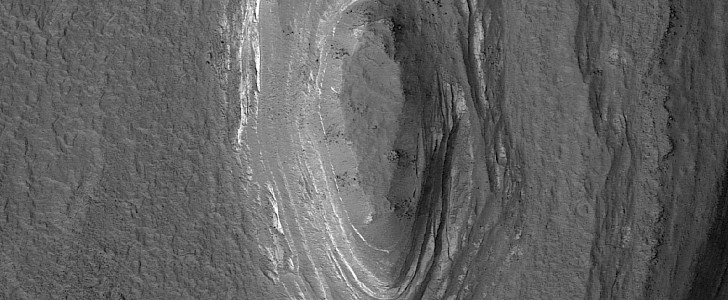It’s hard to imagine how conditions presently are on Mars. Sure, we do have a large amount of hardware there studying the place, but remote observation doesn’t really give us a sense of how things are on a planet we might as well call home in the not-so-distant future.
Even harder is to imagine Mars as anything else than a vast, cratered reddish desert dotted from place to place with ginormous volcanoes. Yet there was a time when the planet was entirely different. Maybe not really Earth-like, with vegetation and life large enough to make an impact on the environment, but completely different than it is today.
Mars once had water, and that’s one of the building blocks of life as we know it. We know that from the observations made over the years – observations that took us from believing the place was always a desert to seeing signs of the substance literally everywhere. Even on this lone hill in the Hellas Planitia region of the world.
We’re looking at something scientists call butte, which is in essence a lonely flat top hill born over eons as a result of erosion performed by wind, water, or ice. This one is layered, leading scientists to believe it may have been “part of a lake that some have suggested existed in Hellas, the largest impact basin on the Red Planet.”
The photo of the butte was snapped by the HiRISE camera from an altitude of 260 km (162 km) back in June 2020, and it is helping scientists “examine a butte with many exposed and well-defined layers,” in an attempt to get a deeper understanding about the neighboring world.
As for the region holding this feature, Hellas Planitia is one of the top five largest impact craters in the Solar System. It has a diameter of 1,400 miles (2,253 km), and in places is up to 9,800 feet (3 km) deep.
Mars once had water, and that’s one of the building blocks of life as we know it. We know that from the observations made over the years – observations that took us from believing the place was always a desert to seeing signs of the substance literally everywhere. Even on this lone hill in the Hellas Planitia region of the world.
We’re looking at something scientists call butte, which is in essence a lonely flat top hill born over eons as a result of erosion performed by wind, water, or ice. This one is layered, leading scientists to believe it may have been “part of a lake that some have suggested existed in Hellas, the largest impact basin on the Red Planet.”
The photo of the butte was snapped by the HiRISE camera from an altitude of 260 km (162 km) back in June 2020, and it is helping scientists “examine a butte with many exposed and well-defined layers,” in an attempt to get a deeper understanding about the neighboring world.
As for the region holding this feature, Hellas Planitia is one of the top five largest impact craters in the Solar System. It has a diameter of 1,400 miles (2,253 km), and in places is up to 9,800 feet (3 km) deep.






